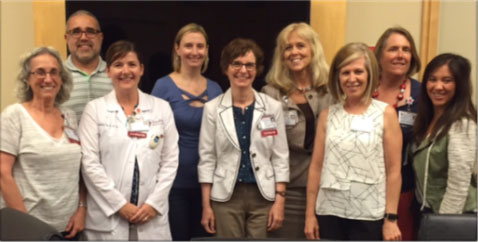Partnering with Patients and Families in Research Design:
What's Said vs. Heard During ICU Bedside Rounds

Stanford Health Care is a 613-bed, not-for-profit academic medical center located between San Jose and San Francisco in suburban Silicon Valley. Stanford Health Care is known for its tertiary and quaternary care and treatments for rare and complex disorders as well as for translating important medical breakthroughs into patient care. Stanford Health Care has Magnet® status with third designation distinction.
The Patient and Family Partner Program (PFPP), initiated in 2009, has three major components: Patient & Family Partners in:
- 16 PFACs
- Patient & Family Faculty/Speaker’s Bureau
- Projects and committees for Continuous Improvement
Currently, there are more than 140 Patient and Family Partners (PFP) who volunteer and who are embedded in all improvement and development efforts. They are not advisors, but rather advocates and partners who are instrumental in understanding problems and designing solutions.
As a Project Site for Creating Capacity for Sustainable Partnerships with Patients and Families in Research, all 17 PFACs at Stanford were invited to a session to learn about the grant and the opportunity to partner to develop a research protocol.
The ICU PFAC volunteered for the project. In approaching research, this philosophy of full partnership was deployed through the ICU PFAC. The consistent focus of this two-year old PFAC has been communication between patients, families and clinical team, and physician bedside rounds was selected by the PFAC as the subject of inquiry. Various aspects of rounds were studied through audiovisual recording of bedside rounds, attending to discrepancies between what physicians believe they have communicated and what patients and families understand. The initial study will serve as the basis for a larger proposal to study all aspects of communication in an ICU.
PFP’s were involved from the beginning. Since research was a new concept to PFAC, they had to be educated and all team members learned to be flexible as project direction changed several times. Additionally while one meeting per month gave time for reflections, it did slow down the process and members had to learn to be patient. At least 75% of the work on the project was conducted within the ICU PFAC meetings, with PFP’s enthusiastically involved. However on several occasions, between meeting conversations were scheduled with key PFPs to keep the project moving.
Team members included:
- Mary Lough, PhD, RN, CNS, FCCM, Clinical Nurse Specialist for Evidenced Based Practice
- Laura Jammal, BA, MPA, Patient & Family Partner
- Joanne Koltnow, Patient & Family Partner
- Joan Forte Scott, MBA, BSN, NE-BC, Administrative Director, Patient & Community Engagement (Retired)
- Mary Song, Program Manager, Patient & Family Partner Program